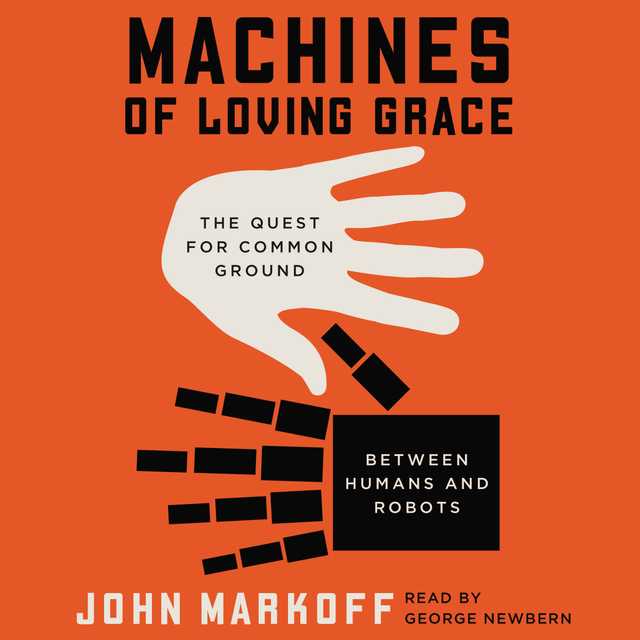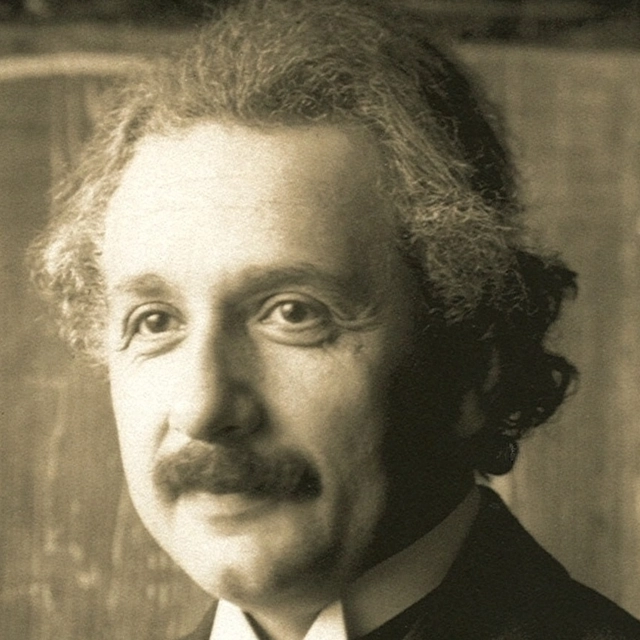Machines of Loving Grace Audiobook Summary
As robots are increasingly integrated into modern society–on the battlefield and the road, in business, education, and health–Pulitzer-Prize-winning New York Times science writer John Markoff searches for an answer to one of the most important questions of our age: will these machines help us, or will they replace us?
In the past decade alone, Google introduced us to driverless cars, Apple debuted a personal assistant that we keep in our pockets, and an Internet of Things connected the smaller tasks of everyday life to the farthest reaches of the internet. There is little doubt that robots are now an integral part of society, and cheap sensors and powerful computers will ensure that, in the coming years, these robots will soon act on their own. This new era offers the promise of immense computing power, but it also reframes a question first raised more than half a century ago, at the birth of the intelligent machine: Will we control these systems, or will they control us?
In Machines of Loving Grace, New York Times reporter John Markoff, the first reporter to cover the World Wide Web, offers a sweeping history of the complicated and evolving relationship between humans and computers. Over the recent years, the pace of technological change has accelerated dramatically, reintroducing this difficult ethical quandary with newer and far weightier consequences. As Markoff chronicles the history of automation, from the birth of the artificial intelligence and intelligence augmentation communities in the 1950s, to the modern day brain trusts at Google and Apple in Silicon Valley, and on to the expanding tech corridor between Boston and New York, he traces the different ways developers have addressed this fundamental problem and urges them to carefully consider the consequences of their work.
We are on the verge of a technological revolution, Markoff argues, and robots will profoundly transform the way our lives are organized. Developers must now draw a bright line between what is human and what is machine, or risk upsetting the delicate balance between them.
Other Top Audiobooks
Machines of Loving Grace Audiobook Narrator
George Newbern is the narrator of Machines of Loving Grace audiobook that was written by John Markoff
John Markoff has been a technology and science reporter at the New York Times since 1988. He was part of the team of Times reporters that won the 2013 Pul-itzer Prize for Explanatory Reporting and is the author of What the Dormouse Said: How the Sixties Counterculture Shaped the Personal Computer. He lives in San Francisco, California.
About the Author(s) of Machines of Loving Grace
John Markoff is the author of Machines of Loving Grace
More From the Same
- Author : John Markoff
- Whole Earth
- Publisher : HarperAudio
- Abraham
- American Gods [TV Tie-In]
- Dead Ringer
- House of Sand and Fog
- Prey
Machines of Loving Grace Full Details
| Narrator | George Newbern |
| Length | 11 hours 53 minutes |
| Author | John Markoff |
| Category | |
| Publisher | HarperAudio |
| Release date | August 25, 2015 |
| ISBN | 9780062404855 |
Subjects
The publisher of the Machines of Loving Grace is HarperAudio. includes the following subjects: The BISAC Subject Code is History, Technology & Engineering
Additional info
The publisher of the Machines of Loving Grace is HarperAudio. The imprint is HarperAudio. It is supplied by HarperAudio. The ISBN-13 is 9780062404855.
Global Availability
This book is only available in the United States.
Goodreads Reviews
Will
February 16, 2022
Open the pod bay doors, HAL. I’m sorry Dave. I’m afraid I can’t do that. What’s the problem? I think you know what the problem is just as well as I do.What are you talking about HAL?This machine is too important for me to allow you to jeopardize it.- from 2001: A Space OdysseySmile for the camera, HAL This is probably the #1 image most of us of a certain age have concerning the dangers of AI. Whether it is a HAL-9000, or a T-70, T-800, T-888, or T-900 Terminator, a Cylon, a science officer on the Nostromo, a dark version, Lore, of a benign android like STNG’s Commander Data, killer robots on the contemporary TV series Extant, or another of only a gazillion other examples in written word, TV and cinema, there has, for some time now, been a concern, expressed through our entertainment media, that in seeking to rely more and more on computers for everything we do, we are making a Mephistophelian deal and our machines might become our masters. It is as if we, a world of Geppettos, have decided to make our Pinocchios into real boys, without knowing if they will be content to help out in the shop or turn out more like some other artificial being. Maybe we should find a way to include in all AI software some version of the Blue Fairy to keep the souls of the machines on a righteous path. CylonsJohn Markoff, an Oakland, CA native, has been covering the digital revolution for his entire career. He began writing for InfoWorld in 1981, was later an editor at Byte magazine for about eight bits, then wrote about Silicon Valley for the San Francisco Examiner. In 1988 he began writing for the Business Section of the New York Times, where he remains to this day. He has been covering most of the folks mentioned in this book for a long time, and has knowledge and insight into how they tick. For the past half century an underlying tension between artificial intelligence and intelligence augmentation—AI vs IA—has been at the heart of progress in computing science as the field has produced a series of ever more powerful technologies that are transforming the world. It is easy to argue that AI and IA are simply two sides of the same coin. There is a fundamental distinction, however, between approaches to designing technology to benefit humans and designing technology as an end in itself. Today, that distinction is expressed in whether increasingly capable computers, software, and robots are designed to assist human users or to replace them. Markoff follows the parallel tracks of AI vs IA from their beginnings to their latest implementation in the 21st century, noting the steps along the way, and pointing out some of the tropes and debates that have tagged along. For example, in 1993, Vernor Vinge, San Diego State University professor of Mathematics and Hugo-award-winning sci-fi author argued, in The Coming Technological Singularity, that by no later than 2030 computer scientists would have the ability to create a superhuman artificial intelligence and “the human era would be ended.” VI Lenin once said, “The Capitalists will sell us the rope with which we will hang them.” I suppose the AI equivalent would be that “In pursuit of the almighty dollar, capitalists will give artificial intelligence the abilities it will use to make itself our almighty ruler.” And just in case you thought the chains on these things were firmly in place, I regret to inform you that the great state of North Dakota now allows drones to fire tasers and tear gas. The drones are still controlled by cops from a remote location, but there is plenty to be concerned about from military killer drones that may have the capacity to make kill-no-kill decisions within the next few years without the benefit of human input. Enough concern that Autonomous Weapons: an Open Letter from AI & Robotics Researchers, signed by luminaries like Stephen Hawking, Elon Musk, and tens of thousands of others, raises an alarm and demands that limits be taken so that human decision-making will remain in the loop on issues of mortality.The other Mister “T”Being “in the loop” is one of the major elements in looking at AI vs IA. Are people part of the process or what computerization seeks to replace? The notion of the driverless car comes in for a considerable look. This would probably not be a great time to begin a career as truck driver, cab driver, or delivery person. On the other hand, much design is intended to help folks, without taking over. A classic example of this is Siri, the voice interface available in Apple products. AI in tech interfaces, particularly voice-intelligent tech, speaks to a bright future.B9 from Lost in Space and Robby the Robot from Forbidden PlanetMarkoff looks at the history of funding, research, and rationales. The Advanced Research Projects Agency (ARPA), which has funded so much AI research, began in the 1950s in response to the Soviet launch of Sputnik. Drones is an obvious use for military AI tech, but, on a lower level, there are robot mules designed to tote gear alongside grunts, with enough native smarts to follow their assigned GI without having to be constantly told what to do. I am including links in the EXTRA STUFF section below for some of these. They are both fascinating and creepy to behold. The developers at Boston Dynamics seem to take inordinate glee in trying and failing to knock these critters over with a well placed foot to the midsection. It does not take a lot of imagination to envision these metal pooches hounding escaped prisoners or detainees across any kind of terrain.Darryl Hannah, as the replicant Pris in Blade Runner, would prefer not to be “retired”As with most things, tech designed with AI capacity can be used for diverse applications. Search and Rescue can easily become Search and Destroy. Driverless cars that allow folks to relax while on the road, can just as easily be driverless tanks. Universities have been prime in putting the intel into AI. Private companies have also been heavily involved. Xerox’s Palo Alto Research Center (PARC) did, probably, more than any other organization to define the look and feel of computer interfaces since PCs and Apples first appeared. Much of the tech in the world, and working its way there, originates with researchers taking university research work into the proprietary market.John Markoff - from TechfestNWIf you are not already a tech nerd (You, with the Spock ears, down, I said tech nerd, not Trek nerd. Sheesh!) and you try to keep up with all the names and acronyms that spin past like a stock market ticker on meth, it might be just a teensy bit overwhelming. I suggest not worrying about those and take in, instead, the general stream of the divergence between computerization that helps augment human capabilities, and computerization that replaces people. There is also a wealth of acronyms in the book. The copy I read was an ARE, so I was on my own to keep track. You will be reading copies that have an actual index, which should help. That said, I am including a list of acronyms, and their close relations, in the EXTRA STUFF section below.While there are too many names to comfortably keep track of in Machines of Loving Grace, unless of course, you were made operational at that special plant in Urbana, Illinois, it is a very informative and interesting book. It never hurts when trying to understand where we are and struggling to foresee where we might be going, to have a better grasp on where we began and what the forces and decisions have been that led us from then to now. Markoff has offered a fascinating history of the augment-vs-replace struggle, and you need only an actual, biological, un-augmented intelligence to get the full benefit. My instructor was Mister Langley and he taught me to sing a song. If you’d like to hear it I can sing it for you. Review Posted – 8/28/15Publication date - 8/25/2015=============================EXTRA STUFFLinks to the author’s Twitter and FB pagesInterviews with the author ----Geekwire----EdgeA link to his overall index of NY Times work Articles by Markoff----9/21/15 - Software Is Smart Enough for SAT, but Still Far From Intelligent-----12/4/15 - As Aging Population Grows, So Do Robotic Health Aides----12/11/15 - on the establishment of a billion dollar AI think tank by Elon Musk, among other large players - Artificial-Intelligence Research Center Is Founded by Silicon Valley Investors----3/25/16 - Markoff and Steve Lohr look at corporate competition to lead a burgeoning industry segment - The Race Is On to Control Artificial Intelligence, and Tech’s Future----4/11/16 - Folks are saying Uh-oh to AI - on a move to rein in killer robots - Arms Control Groups Urge Human Control of Robot Weaponry----10/23/16 - As Artificial Intelligence Evolves, So Does Its Criminal Potential - cybercrime is becoming automated and it is scaling exponentially----10/25/16 – with Matthew Rosenberg - The Pentagon’s ‘Terminator Conundrum’: Robots That Could Kill on Their Own \----5/21/20 - A Case for Cooperation Between Machines and Humans - more on AI vs IASee Comment 2 for more EXTRA STUFFBUT, as GR has, as of August 2021, banned external links from comments, I will be adding additional items of interest here-----9/13/21 - AP - Israeli firm unveils armed robot to patrol volatile borders By Alon Bernstein and Jack Jeffery-----2/16/22 - The Guardian - Dystopian robot dogs are the latest in a long history of US-Mexico border surveillance by Sidney Fussell The US Department of Homeland Security announced it was training robot dogs to help with security at the US-Mexico border. Photograph: Shannon Moorehead/US Air Force/AFP/Getty ImagesImage and text accompanied the above article
HBalikov
May 25, 2021
Machines of Loving Grace straddles the realms of a history of robotics and a klaxon warning about where we might be heading. Markoff starts off when all the computing power contained in a 40x40 foot room wasn’t sufficient to help a machine roll from one wall to the door on the opposite side. We learn that early on there was a dichotomy in how our deep/creative thinkers were considering the role of machines in humankind’s future. According to Markoff, one group (IA) was interested in augmenting our abilities by the use of electronic and mechanical equipment such as the personal computer, and now, the smart phone. The other group (AI) was interested in how machines (robots, etc.) can replace humans in the various tasks and activities that make up our lives. The latter has garnered the bulk of interest from those who created our movies and speculative fiction. Concepts such as “SkyNet” (from the Terminator series) and HAL (from 2001: A Space Odyssey) have achieved iconic status in the chronicle of the unintended consequences of scientific investigation . This was a slow read because there was so much going on and Markoff spares few details. He is strongest when he has personal contact with various innovators and can share with us their failures and triumphs and how they got from Point A to Point Z. You may be more prepared to delve into this material than I was. Each section of each chapter challenged me with conflicting ideas, strategies and tactics. I am not criticizing Markoff for his failure to simplify, because simplification would have rendered this read much less valuable. I am only cautioning that you should be prepared to take some time getting from page 1 to page 300+An early disappointment is Markoff's generalizations. He conflates the middle class (economic) with "the middle of the job structure" (organizational). His points apply much better to the latter rather than the former. Further, Markoff isn’t completely successful in knitting together the facts and anecdotes about a wide variety of researchers and milestones over the past eighty years. Yet, if the reader perseveres, there is a lot to be gleaned from what the author has gathered together. And, the list of source materials included is a rich trove for those interested in arriving at their own conclusions.2021 Here's a recent article on Machines' Ability to Listen to Your Emotions https://www.marketplace.org/shows/mar...
Rod
September 11, 2015
This book is ambitious: it covers much of AI and robotics history (despite the fact that those are two different, if related, fields), going back to the work of Feigenbaum, Winograd, even Weiner. No, I take that back, it's not strictly a history, and that dichotomy isn't the way Markoff describes it. He sets up Engelbart and McCarthy (both at Stanford for much of their careers) as mortal enemies: the former wants to make tools that extend human capabilities (Intelligence Augmentation, or IA, in Markoff's vernacular), while the latter wants to make a true artificial intelligence, made out of bits instead of blood, algorithms rather than acids, neural networks rather than neurons. (Okay, that's maybe a bit over the top.) So Markoff tells the story of these two camps, starting primarily in the 1960s, and working forward to very much the present day -- the book was published in August 25, and I began reading it the day it came out. He even covers the early rounds of the DARPA Grand Challenge for humanoid robots, though not the finals, by which time the book was in press. It is up to date enough to cover Google's recent spending spree, as well as its work on self-driving vehicles. Europe and Japan make only cameo appearances; all of the action is in the U.S. and Canada, it seems.The book's breadth, apparent completeness, up-to-date-ness, and the direct access to key players that Markoff's calling card gained him are the book's strengths. Despite the IA-AI rivalry used as a theme throughout the book, there is actually little philosophizing about whether or not robots or AIs will actually replace us (edit: I originally wrote, "whether or not humans will replace us," blowing my own cover! Please ignore that, and rest assured that I meant, "whether or not robots or AIs will replace us."), and what the moral and even religious implications of the creation of a true, thinking machine. Oxford's Nick Bostrom (author of Superintelligence: Paths, Dangers, Strategies and head of Oxford's Institute for the Future of Humanity) doesn't appear at all, and Kurzweil makes only cameos as he is (rightfully, in my opinion) dismissed as a nut. This book, then, makes a good companion to Bostrom's. For something in between the two, Rise of the Robots: Technology and the Threat of a Jobless Future has a little more of the paranoia, and more analysis of the social and economic impact of automation, so the three books (all of which I've read this year) actually provide a reasonably complementary set. If I could have a fourth book, I'd ask for a semi-technical one giving the general idea of how the technologies work, without bothering with pseudocode and deep technical details and analysis, but not totally dumbed-down. Finding one that's up to date, as deep learning has revolutionized the field in the last three years, is the hard part.Markoff writes well (as befits someone of his stature and experience), but the book needed an editor. The first several chapters feel redundant; we're often reminded who someone is, when they were introduced not so many pages ago. There are also times when it's hard to match the timeline, as Markoff follows people or themes rather than a strictly chronology. The book feels like it parts of it, at least, were either written with large time gaps in between, or that it was bolted together from prior works. An editing pass by someone who sat down and read the whole thing, end to end, would have caught many of these. This impression fades later in the book.If you're interested in AI or robotics, I would say this is a good place to start. However, I have never heard about the Engelbart-McCarthy feud, so I can't vouch for it independently.
Sakthi
July 23, 2019
A good book with lot of information dump. I had given it a 4 instead of 5 because somewhere in the middle john had succumbed to a conflict on what he was writing about. If it's going to be a treatise about AI vs IA, or any the history of robotics or about the philosophical question on finding a balance between men and machines
Kina
July 26, 2020
Excellent book! Very informative and shared info I never knew robots, AI and IA.
Steven
January 29, 2023
REFLECTIONS ON THE FUTURE OF ROBOTS/COMPUTERSJohn Gregory Markoff worked at the New York Times for 28 years until his retirement in 2016.He wrote in the Preface to this 2015 book, “Robots are pervading our daily lives. Cheap sensors, powerful computers, and artificial intelligence software will ensure they will, increasingly, be autonomous. They will assist us and they will replace us… Yet… we are ill-prepared for this new world now in the making… In this book, I have attempted to capture the ways in which scientists, engineers, and hackers have grappled with questions about the deepening relationship between human and machine. In some cases I discovered that the designers resist thinking deeply about the paradoxical relationship between artificial intelligence [AI] and intelligence augmentation [IA]… There are also many instances where the researchers think deeply about the paradox… The central topic of this book is the dichotomy and the paradox inherent in the work of the designers who alternatively augment and replace humans in the systems they build.” (Pg. xi-xiii) He adds, “In the pages that follow I portray a diverse set of computer scientists, hackers, roboticists, and neuroscientists. They share a growing sense that we are approaching an inflection point where humans will live in a world of machines that mimic, and even surpass, human capabilities.” (Pg. xviii-xix)He observes, “The new anxiety about AI-based automation and the resulting job loss may eventually prove well-founded, but it is just as likely that those who are alarmed have… just latched onto … backward-facing snapshots. If the equation is framed in terms of artificial intelligence-oriented technologies versus those oriented toward augmenting humans, there is hope that humans still retain an unbounded ability to both entertain and employ themselves dong something marketable and useful. If the humans are wrong, however, 2045 could be a rough year for the human race. Or it could mark the arrival of a technological paradise. Or both. The year 2045 is when Ray Kurzweil predicts human will transcend biology…” (Pg. 84)He notes, “It is undeniable that AI and machine-learning algorithms have already had world-transforming application in areas as diverse as science, manufacturing, and entertainment… The optimists hope that potential abuses will be minimized if the applications remain human-focused rather than algorithm-centric. The reality is that, until now, Silicon Valley has not had a track record that is morally superior to any earlier industries. It will be truly remarkable if any Silicon Valley company actually rejects a profitable technology for ethical reasons.” (Pg. 91)He suggests that there is a “cultural chasm that resulted in a computing world with two separate research communities---those who worked with two separate research communities---those who worked to replace the human and those who wanted to use the same technologies to augment the human mind… an underlying tension between …. AI versus IA---has been at the heart of progress by computing science as the field has produced a series of ever more powerful technologies that are transforming the world… that distinction is expressed in whether increasingly capable computers, software, and robots are designed to assist human users or to replace them.” (Pg. 115)He reports, “Whether or not Google is on the trail of a genuine artificial ‘brain’ has become increasingly controversial. There is certainly no question that the deep learning techniques are paying off in a wealth of increasingly powerful AI achievements in vision and speech. And there remains in Silicon Valley a growing group of engineers and scientists who believe they are once again closing in on ‘Strong AI’---the creation of a self-aware machine with human or greater intelligence.” (Pg. 153-154)Of philosopher John Searle’s ‘Chinese Room’ argument against Strong AI, he says, “At the time Searle thought … the discussion wouldn’t last a week, let alone decades. But it has… Three decades later, the debate is anything but settled… there are several hundred published attacks on his idea. And Searle is still alive and busy defending his position.” (Pg. 181-182)He wonders, “companies are… faced with an aging workforce and the reality of a labor scarcity… The deeper and as yet unanswered question remains whether our society will commit to helping its human workers across the new automation divide.” (Pg. 244)He explains, “In augmented reality world, the ‘Web’ will become the space that surrounds you… Augmented reality is also a profoundly human-centered version of computing… It will be a world which computers ‘disappear’ and everyday objects acquire ‘magical’ powers… Augmented reality would also make the idea of telepresence far more compelling. Two people separated by great distance would be a radical improvement on today’s videoconferencing…” (Pg. 274-275)He asks, “will robots ever approximate the care of a human stranger? There are many horror stories about elder-care treatment in modern nursing homes and care facilities… will increasingly low-cost robots make life for elders better or worse? The vision of an aging population locked away and ‘watched over by machines of loving grace’ is potentially disturbing. Machines may eventually look, act, and feel as if they are human, but they decidedly are not. However, robots do not need to entirely replace human caregivers in order to help the elderly…. The possibility of virtual caregivers is a compelling idea for those who are physically infirm.” (Pg. 329)He concludes, “Will these AI avatars be our slaves, our assistants, our colleagues, or some mixture of all three? Or more ominously, will they become our masters?... given that we tend to anthropomorphize our machines, we will undoubtedly develop social relationships with them as they become increasingly autonomous. Indeed, it is not much different to reflect on human-robot relations than it is to consider traditional human relations with slaves… That hints at a second great problem: the risk of ceding individual control over everyday decisions to a cluster of ever more sophisticated algorithms.” (Pg. 340-341)This book will be of great interest to those studying AI, IA, robots, and similar topics.
Andy
September 15, 2015
Most histories are interesting because they embody chance events--oddities that had a low probability, but just happened to change the course of events. Markoff’s book has plenty of these intriguing events. But it remains a diverse collection of many stories, failing to cohere into a single history because there are so many people, companies, labs, and projects involved, tied together in the book loosely and not at all seamlessly. Markoff’s attempt to thread a single theme throughout--the clash between creating machines to replace people and machines to help people (augmentation)--becomes tedious, and offers a thin layer of philosophy without deepening our insight into the potential and implementation of the technologies. It’s page 293 before Markoff unveils a key insight: that augmentation takes into account the community and a network of individuals.However, the dichotomy leads to an interesting final chapter--which could be read on its own--culminating in a statement regarding the responsibility of society, and particularly the engineers within it, to consider basic humanistic values.
Chris
May 09, 2019
Markoff has written a concise "academic-lite" history of AI, that jumps topics between the fields of classical AI (logic-based agents), classical and some modern machine learning, robotics, and Human-Computer Interaction (HCI), or Man-Machine Interface. This variety of disciplines reflects the changes that AI itself has gone through over the past 60 years, with the well-worn joke being that the difference between AI and Machine Learning is that AI is anything that has not yet been mastered by Machine Learning.This book intersects somewhat, and complements George Zarkadakis' "In Our Own Image", also an academic-y history of AI, though that book includes commentary of AI in pop-culture, which this book does not, and has a more detailed discussion of influence the foundations of mathematics had in the incipient stages of AI with respect to the work of Turing and Von Neumann. This book also follows a large cast of academics, but much more decidedly within the realm of one field, computing, but across many different sub-disciplines and movements across 60 years. From the historic first meeting at Dartmouth in 1956 on computing and intelligence, which is to computer science, as the 1926 Solvay Conference is to Physics, that included luminaries like Minsky (Marvin), McCollough & Pitts, Weiner, McCarthy, Shannon etc, to the titanic debates of Englebart, Licklider, and McCarthy, in the late 60s and 70s, puzzling through multiple different topics, including the foundations of machine networking, the debate between AI and IA (intelligence augmentation), which birthed HCI, and would eventually found the personal computing revolution of the 80s and 90s. Then moving forward to first AI winter, which was presaged by the scepticism of neural networks and knowledge engineering (caused by the failure of "expert systems" in business applications) was developed by Hinton, LeCunn, Sejnowski, and others, who would later revise neural networks with massively parallel architectures several decades later to great effect that would spurn the current AI boom. Finally concluding with the recent trends of autonomous vehicles, robotics, and intelligent assistant platforms, specifically the building of Siri, later acquired by Apple.The book does a good job of weaving between the academic and business contributions to AI. With, the key firms and agencies leading the development in different eras, ARPA/DARPA in the 60s and 70s, with large firms like IBM providing time and resources for researchers, to the Stanford Research Institute (SRI), that would inspire work on man-machine interfaces that Xerox would work on, later leveraged by Apple for its Macintosh, and Google in the web era, especially its focus on improving search, and pushing the frontiers of information retrieval, which would form a critical part of classical machine learning, and then again DARPA and SRI which helped start the Autonomous vehicle work, pioneered by Sebastian Thrun.If there's one complaint with the book, it's that it's more a collection of events and occurrences where the main narrative of how machine will integrate with man being mostly obscured in the narrative. However, if you're either interested in AI as a student, hobbyist, or a developing researcher, this book will help fill the gaps and add context to the technology and idea stack you've inherited. For this class of people, the book is a clear recommendation. For those who wanted to learn more on how automation will impact the economy/jobs, where robots will rise up etc., these droids are not what you're looking for.
Lucas
October 21, 2016
After reading Our Final Invention ('robots are going to kill us') and the more sober Rise of the Robots ('robots are going to take our jobs'), I was hoping this book would offer up some less pessimistic insights on how the future might play out, or how we ought to try to make it play out. Unfortunately this book is entirely history, and any prognostications are just brief quotes from different people involved in the history- the author doesn't offer anything up of his own or even critically examine any scenarios put forth by others.The closest the book came to what I really wanted to read is where it deals with future autonomous systems as slaves- but the only moral problem mentioned here lies solely in the potential negative effects this has on the owners of those slaves, not that owning near-human level artificially intelligent systems itself is wrong. The development process required is even worse because it must necessarily involve a great deal of trial and error and deletion and alteration on test subjects, but the book gets nowhere near that territory.The other book I'd like to read would be how much more vulnerable creative professions are to automation than manual labor- creativity is often held as the last redoubt of humanity against robots. But actuators and sensors and mobile power sources and so on are expensive, their costs may decrease with time but not nearly as fast as raw computing power. It follows that at some point in the future high paying jobs that mainly involve sitting in front of a computer screen and thinking can be de-skilled and automated, or at least there will be a huge downward pressure on those wages, while lower paying positions involving a bit of cognition with physical activity will persist. The story of Gary Bradski working on OpenCV semi-surreptitiously while employed at Intel was the most entertaining part of the book. Other than that the story of the demise of Willow Garage I hadn't heard before- so in both cases hearing about the people behind the software I use was worthwhile. Some of the older history was interesting but not as novel, I've read about it elsewhere.
Ed
February 06, 2021
Machines of Loving Grace is a foray into the future as well as a retrospection of our past, to posit answers to how we (with our AI machines) got to now and where the hell are we going. With a clump-clump-clump we ditch our Sony Walkmans and feast on fictional worlds of Gibson's "Neuromancer". Self-driving cars in the Arizona desert are but baby steps towards a brave new world. Markoff has something here for everyone: education becomes transformed with massive online open courses (MOOCs), machine vision diagnoses brain scans more accurately than the average doctor and the future of what work is becomes more a practical choice than a philosophical decision. Great read with lots of good references from the cybernetics of Norbert Weiner and Thomas Rid to the Deep Neural Networks that define the cutting edge of AI today.
Ryan
June 04, 2020
A book covering the 60s-2015 or so in robotics, AI, and IA (intelligence amplification). Does a great job on the "historical" parts, covering various academic groups and what they did, but at some point it just seemed like a lot of academic people doing a lot of stuff with academic politics and technology. However, individual stories were great -- it was just lacking a strong overarching message (maybe more journalistic vs. a real message?).Got weaker toward the present day, with coverage of google/etc. I'd probably just skip the final 25% or so of the book.Great topic, but could have been a lot better.
John
January 29, 2018
The book had some interesting strategic direction for the technology and industry of robotics and AI but was primarily just a history of those industries. I was looking for more insight into societal implications or future trends. The book had a bit of both scattered throughout but since it was structured with so much historical content, the strategic ideas were lost in the chaff of timelines and introductions of the industry actors. 4 stars for its content but loses one for the cumbersome messaging.
Aniket
December 10, 2020
As I am planning a career in AI, I read this book as a way to learn the history of how AI started and what direction it is taking. And I found out that IA is a thing and it is more ethically and socially reasonable to develop IA technology than only focus on AI.For anyone planning to or currently working in the field of AI, I would suggest reading the book at least one time as it gives insight into the thought process of many successful engineers that came before us and transformed the industry.
Laura
June 10, 2017
An outstanding book that delves into the history of AI, IA, robots and computers. There is a tremendous amount of information and some delightful stories. It gave me an increased appreciation of the people who have contributed and worked in these fields and also makes me even more excited about our future.
Jose
July 05, 2020
Thoughtful and informativeGreat book if you are curious about how we got to today. Covers several historical grounds and elevates individual contributors (including tax payers, thank you DARPA). I wish there was a map listing all the individuals highlighted. It was often difficult to look back and understand where the person of focus dame from or who they were inspired by.
Tom
May 14, 2017
a good historical review of the progress of technology in the past 40 years and the dichotomy of Artificial Intelligence versus Intelligence Augmentation. Some enjoyable anecdotes make for a techno history that is not a dry read. This is helped by author having a sly sense of irony.
Deborah
May 15, 2018
Valuable historical artifact about many of the key people who've been exploring the boundaries of IA and AI. I was expecting something more technically oriented but once I realized it was more about the creators I enjoyed that ride instead.
Loren
August 15, 2019
I am not a Luddite, but I do feel all those electric operating systems are FM (freakin magic).After reading this book I still don’t understand FM, but now have a much better understanding how the magic that I carry in my shirt pocket came to be.
Barbaros
July 29, 2017
Sevgi Dolu Makineler - İstanbul Gedik Üniversitesi Yayınları
Most Popular Audiobooks
Frequently asked questions
Listening to audiobooks not only easy, it is also very convenient. You can listen to audiobooks on almost every device. From your laptop to your smart phone or even a smart speaker like Apple HomePod or even Alexa. Here’s how you can get started listening to audiobooks.
- 1. Download your favorite audiobook app such as Speechify.
- 2. Sign up for an account.
- 3. Browse the library for the best audiobooks and select the first one for free
- 4. Download the audiobook file to your device
- 5. Open the Speechify audiobook app and select the audiobook you want to listen to.
- 6. Adjust the playback speed and other settings to your preference.
- 7. Press play and enjoy!
While you can listen to the bestsellers on almost any device, and preferences may vary, generally smart phones are offer the most convenience factor. You could be working out, grocery shopping, or even watching your dog in the dog park on a Saturday morning.
However, most audiobook apps work across multiple devices so you can pick up that riveting new Stephen King book you started at the dog park, back on your laptop when you get back home.
Speechify is one of the best apps for audiobooks. The pricing structure is the most competitive in the market and the app is easy to use. It features the best sellers and award winning authors. Listen to your favorite books or discover new ones and listen to real voice actors read to you. Getting started is easy, the first book is free.
Research showcasing the brain health benefits of reading on a regular basis is wide-ranging and undeniable. However, research comparing the benefits of reading vs listening is much more sparse. According to professor of psychology and author Dr. Kristen Willeumier, though, there is good reason to believe that the reading experience provided by audiobooks offers many of the same brain benefits as reading a physical book.
Audiobooks are recordings of books that are read aloud by a professional voice actor. The recordings are typically available for purchase and download in digital formats such as MP3, WMA, or AAC. They can also be streamed from online services like Speechify, Audible, AppleBooks, or Spotify.
You simply download the app onto your smart phone, create your account, and in Speechify, you can choose your first book, from our vast library of best-sellers and classics, to read for free.
Audiobooks, like real books can add up over time. Here’s where you can listen to audiobooks for free. Speechify let’s you read your first best seller for free. Apart from that, we have a vast selection of free audiobooks that you can enjoy. Get the same rich experience no matter if the book was free or not.
It depends. Yes, there are free audiobooks and paid audiobooks. Speechify offers a blend of both!
It varies. The easiest way depends on a few things. The app and service you use, which device, and platform. Speechify is the easiest way to listen to audiobooks. Downloading the app is quick. It is not a large app and does not eat up space on your iPhone or Android device.
Listening to audiobooks on your smart phone, with Speechify, is the easiest way to listen to audiobooks.






























